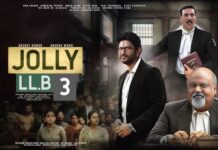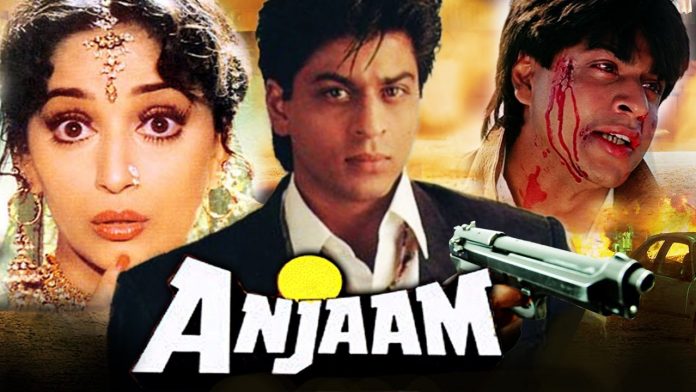ANJAAM
Shiv-Bharat Films’ Anjaam (a) is one more film in which current heartthrob Shah Rukh Khan plays a negative hero, this time more venomous than ever. It is the story of an extremely rich and eccentric boy who must have what he desires. He goes bonkers over a girl and wants her to marry him at any cost. When all his attempts fail, he gets down to ruining her. His philosophy: if she can’t be mine, she can’t be anybody else’s. After a lot of torture, the girl sets out to avenge the atrocities perpetrated on her.
The film has an entertaining and interesting first half although it reminds of Darr at places. But soon after interval, it takes a morbid turn. Tension mounts and the violence is too brutal. Further, Shah Rukh Khan is absent from the scene for a good part of the second half, something that can’t be digested easily, looking to his present craze. Although the end is appropriate, the build-up is quite tame.
Screenplay leaves something to be desired. Hard-hitting dialogues were the need of the drama but, unfortunately, they aren’t so. In fact, the impact of several high-voltage scenes gets diluted because of ordinary dialogues.
Madhuri Dixit gives a wonderful performance and rises above the script, not once going overboard. Shah Rukh Khan is also brilliant, repeating his wild performance of Darr, this time like a true villain. Deepak Tijori is good in a special appearance. Johny Lever is remarkable in the role of a eunuch and provides the much-needed relief. Ghanshyam and Jugnu are okay. Tinnu Anand does a fine job. Beena, Kalpana Iyer, Kiran Kumar, Sudha Chandran, Himani Shivpuri, baby Gazala and Dinesh Hingoo lend formidable support.
Direction is fairly good. Three songs – ‘Main ro-oon ya hasoon’, ‘Chane ke khet mein’ and ‘Tu saamne jab aata hai’ – are extremely well-tuned and their picturisations are also good. ‘Pratighat ki jwala jale’ is effective. Photography and other technical values are of standard. Action is well-composed.
On the whole, Anjaam suffers on account of a weak second half. It has mainly Shah Rukh’s popularity wave (and consequent good initial value) and superlative performance of the two lead players to fall back upon. Average.
Released on 22-4-’94 at Dreamland and 27 other cinemas of Bombay thru Mahalakshmi Film Distributors. Publicity: very good. Opening: very good (affected slightly due to Sharjah cricket match). …….Also released all over. Opening was surprisingly poor in C.I. 1st day Jaipur 92,025/- from 4 cinemas.
LATEST POSITION
The dinosaur has proved to be the star attraction; JURASSIC PARK (Hindi) has done extraordinary business all over. The other two releases of last week were extremely weak.
…..
Jurassic Park (dubbed) proves class A. 1st week Bombay 20,58,463 (84.95%) from 13 cinemas (2 on F.H.), Ganesh, Thana 1,44,646, Tilak, Dombivli 1,45,669, Shriram, Ulhasnagar 1,53,255; Ahmedabad 6,15,811 from 6 cinemas, Baroda 96,436 (83.48%); Pune 3,21,215 (100%) from 4 cinemas (1 in matinee), Kolhapur 62,026 (99.12%), Solapur (14 shows) 49,240, Satara 73,500 (100%), city record, Nasik Road 1,21,257, theatre record, Malegaon 48,503 (99.90%), theatre record; Belgaum 63,089 (100%) from 2 cinemas (1 in noon); Delhi 11,11,863 (98.07%) from 4 cinemas; Kanpur 1,15,680, Agra 1,35,000, Allahabad 1,08,000; Nagpur 4,11,875 from 3 cinemas, Jabalpur 1,01,884, Amravati 90,727, Akola 91,869; Indore 75,875 (100%; 1 cinema on F.H.), Bhopal 81,888; Jaipur 3,27,801 from 2 cinemas; Hyderabad 4,18,797 from 3 cinemas (1 cinema unrecd.).
…….
DO YOU KNOW?
* Shammi Kapoor and Raaj Kumar have been signed together for Pitra Chhaya Productions’ untitled venture. The two will be seen together in the film after many years. They have come together earlier in only one film, UJALA.
* The Bombay municipal Corporation (BMC) authorities dismantled a huge set of a bungalow put up at Madh Island (next to The Retreat) by Mahendra Shah for his SARHAD, even while shooting was in progress on 20th April. The BMC contention was that proper permission had not been taken to construct the set.
B. N. GHOSH NO MORE
Producer B.N. Ghosh expired on 18th April in Bombay. He had produced Waris, starring Jeetendra. He had also worked as Jeetendra’s secretary.
ISHRAT ALI TO WED
Actor Ishrat Ali will get married to Nigar Sultan on 24th April at Vile Parle Club, behind Chandan cinema, Juhu, Bombay.
MAHARASHTRA GOVT.’S CLARIFICATION ON CINEMA FSI
Cinemas in Bombay, which have exceeded the floor space index (FSI) regulations through unauthorised constructions, would be required to reduce their seating capacity, as prescribed, without the necessity of pulling down any part of the structure, under a set of clarifications issued by the Maharashtra government. The government has also stipulated conditions, subject to which proposals for reducing seating capacities of existing cinemas and permitting non-cinema uses in lieu thereof, could be considered.
MIX MASALA
LONG LIVE HER SAREE!
Sudha Chandran, who plays Madhuri Dixit’s sister in Anjaam, is shown wearing the same saree and blouse in almost every scene in which she appears – and the drama spans more than four years! And when Sudha Chandran does finally change her saree, she is killed in an accident. Moral of the story: Don’t change your clothes if you want a long life.
SECOND TIME
Darr is Yash Chopra’s second film which has bagged the National Award for the best popular film providing wholesome entertainment, the first being Chandni in 1989. B.R. Chopra’s Dhar amputra, which was directed by Yash Chopra, had also bagged the National Award.
How Movies Grew Up To Become Videos
Reproduced hereunder is an article that appeared in Los Angeles Times last month. It is also relevant to Indian film business and shows how videos have over taken theatrical business – and thereby benefitted the entertainment industry.
Oscar winner Schindler’s List tells you that a good story will always have value, no matter what develops on the overwrought subjects of information highways and multimedia.
The film, which won the best film and best director awards for Steven Spielberg, can also be a guide to understanding many other things in the entertainment business today. For example, Schindler’s List, which has taken in 60 million dollars at the box office to-date, may do even better in home video rentals – for the very human reason that it is a searing, three-hour movie that many people might find easier to watch in their homes.
But then, more films are seen on home video than on movie screens these days – by a margin that may surprise you. In 1993, video rentals totaled 8.8 billion dollars and home video sales added an other 5.9 billion dollars, according to a major study by analyst Jeffrey Logsdon of Seidler Cos., a Los Angeles investments firm.
That’s almost 15 billion dollars from the U.S. video market, compared to 5.2 billion dollars at the theatrical box-office.
Moreover, video can be more profitable than theatrical distribution for the studios, because they get a higher share of every deal, says analyst David Davis of Paul Kagan & Associates, a Carmel, Calif., research firm. Thanks to the growth of video, movie studio revenues have more than doubled in the last eight years.
The irony is that the studios didn’t see the bonanza coming. In the late 1970s and early 1980s, the video rental business got started in stores owned by record distributors, who first had the idea of selling movies on tape to new owners of videocassette recorders. Later, they moved to renting the films.
But the whole idea made studios uneasy. Warner Bros. and others threatened to withhold films from the storefront mer chants. Then the studios sought to have Congress pass a law limiting the merchants’ business. Fortunately for all involved, Congress listened to local small-business people more than it did big companies.
No action was taken on the matter, and videos became a great and stable source of film industry revenue, contributing importantly to making studios more valuable – witness the recent bidding in which Viacom paid more than 10 billion dollars for Paramount.
How could studio heads a decade ago have missed the promise of such a business? Simple: They yielded to what is called the displacement fallacy – the idea that a new technology displaces a previous one. It doesn’t. Radio continues alongside television, the movie business has adapted and grown with each new wrinkle in distribution – from theaters to television to growing international markets.
The surging business of video cassette sales grew 28% last year, spurred by the runaway success of family films, especially by Walt Disney Co. Disney’s Aladdin took in 286 million dollars in video sales, compared to 217 million dollars at the box-office; Pinocchio had 174 million dollars in video sales, compared to 19 million dollars (worth more than 100 million dollars in today’s dollars) in box-office receipts more than 50 years ago.
A successful film doesn’t have to be a Disney classic. Free Willy, a 20th Century Fox story about a boy and a whale, took in 94 million dollars in video sales after earning 78 million dollars at the box-office.
And a film doesn’t have to be for children, nor even a box-office hit, to score in video rentals. Silver, a steamy thriller panned by critics, that took in only 37 million dollars in theatres, added an other 29 million dollars in rental, possibly turning a loss into a profit for Paramount.
The lesson should be clear for all in Hollywood and investors around the world, who are now trying to predict developments in new media: The more advances and varieties there are in film distribution, the more valuable the movie business becomes.
The latest news is that Pacific Bell is going to test a system for beaming movies digitally over telephone lines directly to theaters, eliminating the costs of duplicating films and delivering canisters.
PacBell will be testing machinery that one day could be used to send movie directly into homes in response to signals from interactive television sets – the much-touted movies on demand. Such wonders will come to pass, no doubt, but not soon and not cheaply.
Technological breakthroughs and major investments will be needed to bring interactive television over fiberoptic cables to homes and neighbourhoods. Analyst Logsdon believes that important thresholds, such as 1 million homes capable of conducting interactive experiments, may be crossed by 1998 or so.
Meanwhile, movies, one of the identifying technologies of the 20th century, will continue to attract growing audiences in the 21st century simply because they reflect an ancient art. They tell stories, as in Schindler’s List, a true story of decency and good surviving and ultimately prevailing against incredible evil.
It is a powerful business.
“I was deeply shocked and outraged……”
Anil Kapoor’s Reply To Vijay Anand
April 21, 1994
Dear Shri Vijay Anand,
Received your letter on 1st April, ’94.
I was deeply shocked and outraged at the entirely one-sided version of its content and I feel, it is in the fitness of things that I respond to your letter point by point.
(1) You said that on the sets of 1942 A Love Story, the two of us (Jackie and myself) inspired you to start a film. What happened was, during the course of a casual conversation, I suggested that you ought to be making films. “If I do, will you work with me?”, you asked, to which I answered, “Sure.” Next, you phoned my office to say that you were announcing the muhurt. Surprised, I rushed Rikoo to request you to delay the project till I had heard the script, a clause that, without exception, extends to all my film makers. But you chose to go ahead with the muhurt in travesty.
(2) You said that, perhaps, we were celebrating the April Fool’s Day with you. Quite frankly, Goldie Sahab, I’m still not sure, who played the April Fool on whom. Considering, I was the injured party, I ought to have scream ed betrayal. Instead, I have been accused, humiliated in print with a threat of emotional blackmail when all I was trying to do was help a senior.
(3) You have mentioned that you are grateful to us both for giving you a master-lesson in human relationships. On the contrary, Sir, I am grateful to you, for, it is through this episode that I’ve learnt how not to let a senior misinterpret the admiration and co-operation of a junior for subjugation.
And finally, your hope that our relationship will remain the same in future. Of course, it will. What I fail to comprehend, though, is why would you want to associate with a man responsible for almost making you jump off the terrace. Can you, Goldie Sahab?
Very sincerely,
Anil Kapoor
South Sweeps National Awards
‘DARR’ BEST WHOLESOME ENTERTAINER
Buddhadeb Dasgupta’s Charachar (Bengali) has been adjudged the best feature film of 1993 in the National Awards announced in New Delhi on 21st April. Mammootty and Shobhana bagged the awards for best actor and best actress, the former for his roles in Ponthan Madaand Vidheyan (both Malayalam) and the latter for Manichitrathazhu (Malayalam).
The Malayalam film industry featured in six awards in the technical awards category. Besides the above two, it bagged the award for the best director (T.V. Chandran for Ponthan Mada), best cinematography (Venu for Ponthan Mada), best music director (Johnson for Ponthan Mada) and best male playback singer (Yesudas for Sopanam).
Darr and Malayalam film Manichitrathazhu, shared the award for the best popular film providing wholesome entertainment. Mahesh Bhatt and Tahir Husain won a special mention for their “innocent comedy”, Hum Hain Rahi Pyar Ke.
Alka Yagnik won the award for the best female playback singer for Hum Hain Rahi Pyar Ke. Neena Gupta and Paresh Rawal were adjudged the best supporting actress and supporting actor for their portrayals in Subhankar Ghosh’s Woh Chhokri. The same film also fetched a special jury award for Pallavi Joshi.
Satyajit Ray will get a posthumous award for the best screenplay for his Bengali film, Uttoran. Renu Saluja won the best editing award for Sardar.
The 41st National Awards were announced by Dr. T. Subbarami Reddy, chairman of the 13-member jury.
Mandhra Phu was adjudged the best feature film in Kodava language, and Bangara Patler, in Tulu language. These languages have been included in the awards this year.
The Indira Gandhi award for the best first film of a director went to Ashok Viswanathan for the Bengali film, Sunya Theke Suru. Ketan Mehta’s Sagar bagged the Nargis Dutt award for the best feature film on national integration. Two films – Janani (Bengali) and Narayam (Malayalam) – shared the Rajat Kamal for the best film on social issues.
The jury made a special mention of producer Jugal Debata and director Susant Misra for their Oriya film, Indradha nura Chhai.
Neena Gupta, besides being adjudged the best supporting actress, will also receive the award for the best non-feature film of a new director, for her documentary, Bazar Sitaram. The other short films which won awards are Aakasha Doothu (Malayalam) and Devara Kadu (Kannada). A.K. Bir’s Lavanya Preeti (Oriya) bagged the award for the best children’s film. It also brought Tarashankar Misra the award for the best child artiste. Malhar Raag got the award for the best non-feature film. Sunday bagged the award for the best short fiction film. Pritiman Sarkar got the critics award. ‘Naalo Nenu’, an autobiography in Telugu by Dr. Bhanumati Rama krishnan, got the award for the best book.
The films which have been awarded the Rajat Kamal (Rs. 20,000) for the best feature films in the various languages are: Abartan (Assamese), Antareen (Bengali), Manavini Bhavai (Gujarati), Patang (Hindi), Chinnari Mutha (Kannada), Vidheyan (Malayalam), Sambal Wangma (Manipuri) and Lapandav (Marathi).
3-E
Education-Entertainment-Enlightenment
Musical Chairs Or Music Sittings?
In the morning and afternoon, he had a music sitting with Anand Milind. The same evening, he had another music sitting with Nadeem Shravan. And in the night, he had his third music sitting of the day, this time with Anu Malik. That’s David Dhawan for you! Yes, the busybee director had three music sittings on one single day this week. Anand Milind are scoring the music of his Coolie No. 1, Nadeem Shravan, of Saajan Chale Sasural, and Anu Malik, of Yaraana.
































